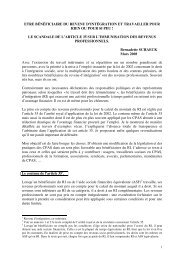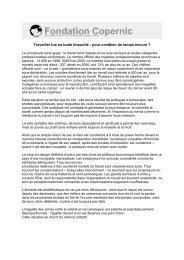Awra Amba RJ 300612 EN - Contacter un comité local d'Attac
Awra Amba RJ 300612 EN - Contacter un comité local d'Attac
Awra Amba RJ 300612 EN - Contacter un comité local d'Attac
Create successful ePaper yourself
Turn your PDF publications into a flip-book with our unique Google optimized e-Paper software.
<strong>Awra</strong> <strong>Amba</strong>, a current experiment of utopian socialism<br />
25 %. As they cannot live only from agriculture due to soil poverty and scarcity, they diversified<br />
their activities with weaving, milling and trade. These activities are conducted mainly within the<br />
cooperative, except weaving, of which an important part is made by each family at home and is<br />
privately managed.<br />
These activities provide an average income per inhabitant, which seems slightly higher than the<br />
regional one, but data provided are not very clear, sometimes contradictory. The food needs of the<br />
inhabitants seem nevertheless fully covered all over the year, while two thirds of Amhara peasants<br />
cover their food need for nine month a year only.<br />
Then we examine the participation to the different agricultural, artisan and household tasks of<br />
women and men, as well as girls and kids. These tasks are mainly distributed according to capacities<br />
of each one and not according to the sex. The survey data provided show that there is equality<br />
between couple members as producers, as consumers, and in terms of task and work responsibility<br />
and of family responsibility.<br />
Marriage is managed by the future spouses, their parents having no role, <strong>un</strong>like the traditional<br />
Amhara rule. The studies give us quite accurate statistics on marriage age, we compare to regional<br />
ones. It appears that there is no early marriage in <strong>Awra</strong> <strong>Amba</strong>, the yo<strong>un</strong>g women getting married<br />
usually between 19 and 22, the yo<strong>un</strong>g men between 20 and 25, while in the regional rural population,<br />
5 % of boys and 8 % of girls between 10 and 14 are already married. The couples have an average of<br />
one child less than the neighbouring ones of the region. A couple may divorce without formality by<br />
mutual consent, their property being shared equally.<br />
The solidarity and the mutual respect between <strong>Awra</strong> <strong>Amba</strong> members are especially implemented for<br />
children. They have three tasks well differentiated: go to school, play, and contribute to comm<strong>un</strong>ity<br />
work. Their participation to household and firstly agriculture tasks is nevertheless very low, but all<br />
are going to school as long as possible according to their capacities and are encouraged to study after<br />
school. The solidarity is also implemented through a system of support of women near delivery, ill<br />
and elderly.<br />
Contrary to the rural Amhara society where f<strong>un</strong>eral ceremonies are attended by a lot of people with<br />
spectacular weeping, they are attended in <strong>Awra</strong> <strong>Amba</strong> only by some people for a very short period (a<br />
few hours). These f<strong>un</strong>eral rites correspond to the social and cultural system of <strong>Awra</strong> <strong>Amba</strong>, whose<br />
members do not believe in a life after the death and privilege the life on Earth.<br />
Finally, to manage the conflicts within the couples and between members of the comm<strong>un</strong>ity, several<br />
permanent bodies have been implemented. They seem very efficient to facilitate dialogue and<br />
manage conflicts in a wise manner.<br />
Then, we study in detail the education within the comm<strong>un</strong>ity, because it is especially important for<br />
them. The learning processes are always directed to the promotion of the group's interest, as well as<br />
of their own. <strong>Awra</strong> <strong>Amba</strong> implemented a self-help or mutual education system, for adults and mainly<br />
for the yo<strong>un</strong>g children who do not go to school and for school children when not at school. This<br />
education is provided by older students and adults from the village, especially through a kindergarten<br />
and a library with many technical books.<br />
All the children who are old enough are going to school. They are very active in social and ethic<br />
activities at school, very good in group discussions, very studious, but not very open to the students<br />
from other villages. The teachers find them more hardworking, more ethical and more cooperative<br />
than the children from neighbouring villages. Therefore, the education level of <strong>Awra</strong> <strong>Amba</strong><br />
members, all from peasant origin, is far higher than the one of the rural comm<strong>un</strong>ities of the region,<br />
with relatively few differences between men and women.<br />
We look finally at the relationships of the comm<strong>un</strong>ity with the neighbouring comm<strong>un</strong>ities,<br />
characterized by suspicion: <strong>Awra</strong> <strong>Amba</strong> people are perceived by their neighbours as a suspicious,<br />
6 / 85

















